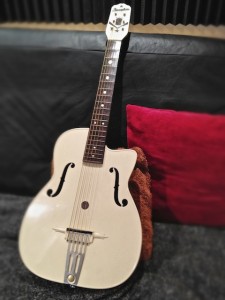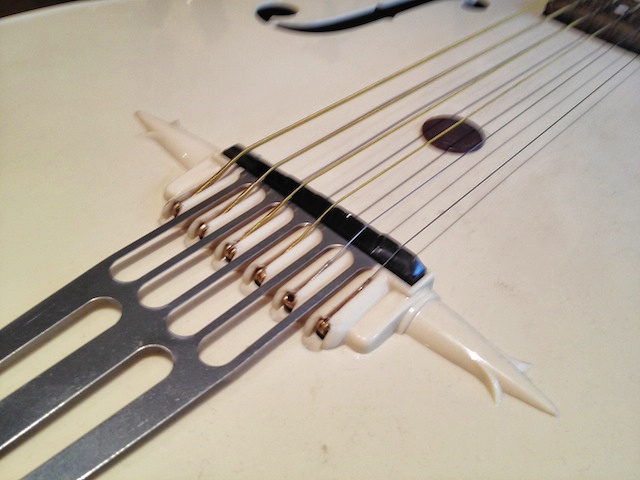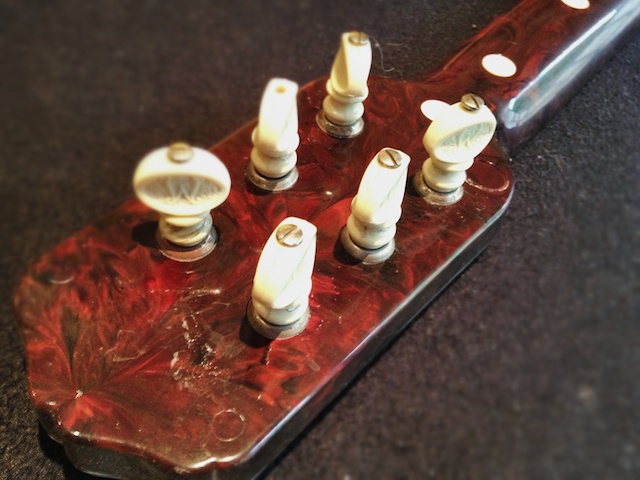In comments to a recent post on 3D-printed guitars, we were discussing the pros, cons, and general aesthetics of instruments molded from plastic. But this isn’t exactly a new idea.
Back in the 1950s, luthier Mario Maccaferri conceived a line of plastic guitars and ukuleles. (This was many years after Maccaferri designed the D-hole Selmer guitars that will forever be associated with the Gypsy jazz of Django Reinhardt.) These plastic guitars were never very popular, and they’re not particularly valuable today.
I bought the one pictured here a few years ago at one of the music shops in London’s Denmark Street (I forget which one). I paid a couple of hundred bucks, and felt like a chump.
But I’ve grown attached to this guitar. It’s lovely to look at, and it plays great. The neck is substantial yet comfy, and it intonates well throughout its range. The tone isn’t warm, complex, or rich. But the Maccaferri has a cool, lo-fi character this sits well in a mix. I also like using it to double conventional acoustic guitars — the sharp, percussive tone adds a rough, aggressive edge.
Have a listen:
One thing that fascinates me about this guitar is the contrast between its “modern” plastic fabrication, and its quaintly archaic design details. There’s something vaguely Art Deco about the bridge assembly:
And check out the detailing on the primitive friction pegs:
I tell you, man — they don’t make cheap-ass plastic guitars like they used to!











Sounds beautiful to my ears; suppose the mic (and player) might have a bit to do with that of course. Love the look too.
A couple of years ago I went on an unsuccessful internet quest to find a cheap Maccaferri and gave up. Damn your video, now I want one again.
Allegedly a plastic Maccaferri is Jeff Beck’s sit-around-the-house guitar of choice.
Bakelite baby!
Definitely! Modern plastic doesn’t have the rich, satisfying tone of vintage plastic. 😉
Looks like it’s actually “Styron”.
https://orgs.usd.edu/nmm/News/Newsletter/August2010/StyronRevolution.html
^^^ I guess I wouldn’t play this next to the fire, then!
sorry, was thinking of celluloid!
Well, wood burns too. But I suppose it doesn’t melt all over your hands.
Wanted a Maccaferri since I first heard Django , never saw one that was actually in my price range till now .
A wacky but compelling tone from a wacky but compelling guitar. I can see how it would sit well in a lot of mixes, inhabiting eq points that would be empty otherwise. And ever so stylish!
Seems like every so often someone makes a new batch of guitars like these. I remember a pretty good run of them in the late 70’s early 80’s. I also remember seeing someone selling copies in the last 5 years or so. But AFAIR the original plastic is difficult to source so it is a somewhat different material. They do have a unique tone.
Nice video. There aren’t many around so it’s especially good to see one with such nice playing. I see you’re missing a screw from one of the tuners. I have a Maccaferri too (the other design) and it too has a screw missing. I wonder if they had a tendency to work loose. I bought a replacement on ebay but it turned out to have a different thread. I currently have mine strung with nylon strings (to up the plastic quotient to the max) and it plays pretty well although It does generate a bit of fingerboard noise if I don’t lift off cleanly. I first saw one of these in the 80’s in a guitar mag, when that batch was discovered and the soon after Dave Stewart played one on TV (TOTP I think). I had me a fierce hankering for one after that. I finally found one on ebay a few years ago. Thank goodness for that, the prices have shot up recently and are now out of my reach.
David
Ray Hennig had a bunch of these years ago at Heart of Texas Music in Austin. Priced cheaply. But again, it was nearly 20 years ago.
Heart of Texas is where Stevie bought # 1, by the way.
Yeah, I’ve heard you used to be able to pick them up for next to nothing. Sadly, I paid considerably more than nothing.
Wow, this blows my mind! As a kid, I got a “Gene Autry” plastic guitar for my 8th birthay. It came with a pushbutton device that played chords(!) Here’s a picture of one on ebay: https://www.ebay.com/itm/Vintage-Gene-Autry-Guitar-1950s-with-Box-by-Emenee-Rare-/321372646611
It’s amazing that someone 50 years ago got the jump on some of today’s synthetic guitar makers.
You’re right, there is something definitely Art-Deco about some of the Selmer’s details and it has a sound of it’s own.
Thanks for another interesting article.
eski
Hi there. These are no friction pegs. In fact they are exact smoothly working geared tuners. The gears are housed inside the headstock plate.
I just recently acquired one of these guitars (a G-40) and am having a guitar tech reset the neck angle with the adjusting screw.
I really like the sound you got out of it. What strings are you using? The one I bought has some truly beat up strings & we can’t tell what the are. Any help will be appreciated.
Those Gene Autry guitars with the chording device was also made my Mario Macaferri. He make those, somewhere between 5 & nine million Islander ukuleles (Arthur Godfrey), the Mickey Mouse guitar with the crank on the side that played a music box inside (rubber roll/band with nubs), the casings for the Emenee Electric Ogran, plastic violins, saxophones and a couple of other instruments.
He actually made his money from plastic clothes pins, which were starting to replace wood in the 1950s (my mother had both varieties, wood [both 1 & 2 piece with spring] and plastic).
He could make all this stuff because he owned the injection molding machines. He really did believe in the plastic musical instruments and wanted people to have quality instruments at a reasonable price.
I still want to know what strings you’re using in that video. I’m thinking of using Savarez New Concept 10s but would like to use 11s if that’s possible.
Plastic guitars,ice cube trays and clothes pins….thank you Mario Mackaferri.